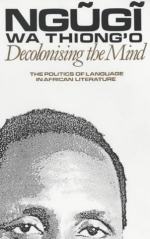
|
| Name: _________________________ | Period: ___________________ |
This test consists of 5 multiple choice questions, 5 short answer questions, and 10 short essay questions.
Multiple Choice Questions
1. In what language did Fumo Liyongo write?
(a) Gĩkũyũ.
(b) Jalaa.
(c) Swahili.
(d) Hausa.
2. What novel of the author's is comprised of stories within stories in a series of flashbacks?
(a) Weep Not, Child.
(b) Petals of Blood.
(c) The River Between.
(d) A Grain of Wheat.
3. Who was the head of the English Department at Nairobi University in 1968?
(a) Dr. Bob Dixon.
(b) Dr. Martin Carter.
(c) Dr. Kim Chi Ha.
(d) Dr. James Stewart.
4. Who wrote Cry, the Beloved Country?
(a) Chinua Achebe.
(b) Amos Tutuola.
(c) Alan Paton.
(d) Obi Wali.
5. What essay from the book Writers in Politics does the author describe in Chapter 4, Part III?
(a) "Literature and Society."
(b) "The Struggle for Cultural Freedom."
(c) "Performance of Literature and Power."
(d) "Literature in Production."
Short Answer Questions
1. What is the central backdrop of Caitaani mũtharaba-Inĩ?
2. Who wrote In the Castle of My Skin?
3. What does the author describe as the ultimate arbiter of form in Chapter 3, Part VI?
4. What metaphor does the author present to describe the differences of perception in Chapter 4, Part I?
5. The author asserts in his conclusion in Chapter 4, Part IX that what this book on the politics of language in African literature is really about is what?
Short Essay Questions
1. What reasons does the author give for Africans studying Caribbean and Afro-American literature?
2. What is the basic demand in the statement presented by the author, Owuor Anyumba, and Taban Lo Liyong at the University of Nairobi?
3. What works did the author assign to his students to read just before his arrest? Why?
4. What is the meaning of the author's metaphor of the blind men and the elephant in Chapter 4, Part I?
5. How does the author define "fiction language"?
6. What does the author remark about Joseph Conrad in regards to narrative perspective?
7. What are the subject and themes in the author's book Homecoming?
8. Who was Bertolt Brecht?
9. What does the author remark about Faust in Chapter 3, Part VIII?
10. What does the author remark about Franz Josef Strauss's official visit to the Independent Republic of Togo in Chapter 3, Part VII?
|
This section contains 830 words (approx. 3 pages at 300 words per page) |

|




